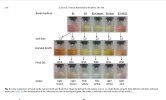My take is that Chromate has real problems, either with equipment or protocol, or both. Those are wildly different results. I would also like to see test equipment details like Analiza displays.
Analiza did not do the retest. She likely just fixed the typo then transmitted the “new“ report. Only my opinion but….
Again, wildly different results.
HPLC, in my limited experience, is not that crazy in variables.
Jano’s report looks legit.
I sent him some samples a few years ago. Simultaneously I ran these samples on a Agilent 1100 which I was purchasing. They came back within a milligram of his reports. I have stated this on another forum in the past and was accused of gargling Jano’s nuts. The Jano hate is strong there, unfortunately.
The purchase of that system failed so to speak due to COVID and the inability to drive to the USA to pick it up. But I am again in the market for one because this testing shit is out of hand.
If I am sending stuff off, it’s going to Jano.
NO brewer is using nearly 50% more primo raws to make their product. I would expect a 10%+/- in milligrams, but nothing more.
Hats off to Stanford if they are getting that accurate!
Analiza did not do the retest. She likely just fixed the typo then transmitted the “new“ report. Only my opinion but….
Again, wildly different results.
HPLC, in my limited experience, is not that crazy in variables.
Jano’s report looks legit.
I sent him some samples a few years ago. Simultaneously I ran these samples on a Agilent 1100 which I was purchasing. They came back within a milligram of his reports. I have stated this on another forum in the past and was accused of gargling Jano’s nuts. The Jano hate is strong there, unfortunately.
The purchase of that system failed so to speak due to COVID and the inability to drive to the USA to pick it up. But I am again in the market for one because this testing shit is out of hand.
If I am sending stuff off, it’s going to Jano.
NO brewer is using nearly 50% more primo raws to make their product. I would expect a 10%+/- in milligrams, but nothing more.
Hats off to Stanford if they are getting that accurate!


